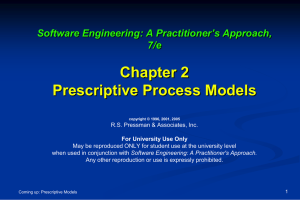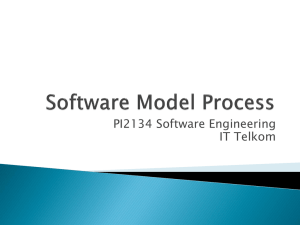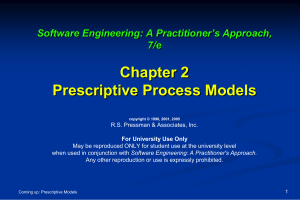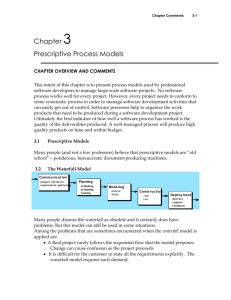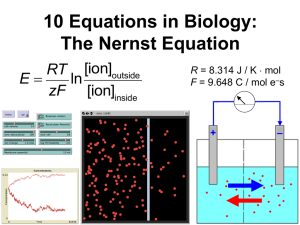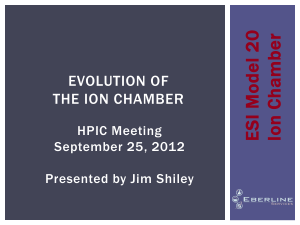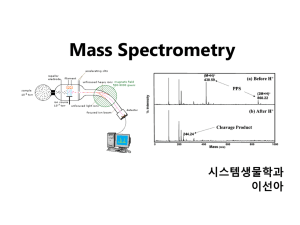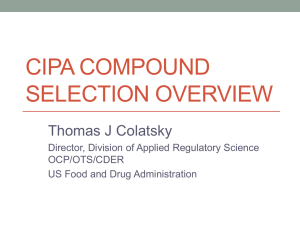Ch 3
advertisement
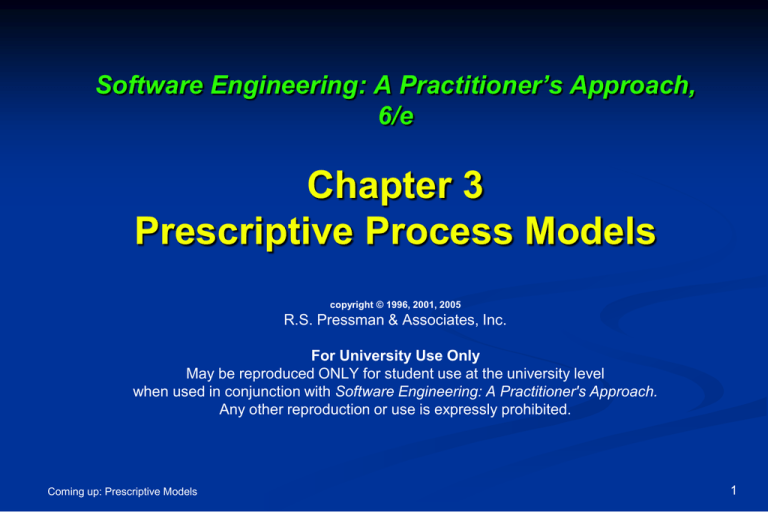
Software Engineering: A Practitioner’s Approach, 6/e Chapter 3 Prescriptive Process Models copyright © 1996, 2001, 2005 R.S. Pressman & Associates, Inc. For University Use Only May be reproduced ONLY for student use at the university level when used in conjunction with Software Engineering: A Practitioner's Approach. Any other reproduction or use is expressly prohibited. Coming up: Prescriptive Models 1 Prescriptive Models Prescriptive process models advocate an orderly approach to software engineering That leads to a few questions … If prescriptive process models strive for structure and order, are they inappropriate for a software world that thrives on change? Yet, if we reject traditional process models (and the order they imply) and replace them with something less structured, do we make it impossible to achieve coordination and coherence in software work? Coming up: The Waterfall Model 2 The Waterfall Model Com m unic a t ion proje c t init ia t ion re quire m e nt ga t he ring Planning estimat ing scheduling tracking Mode ling analysis design Const r uc t ion code t est De ploy m e nt de liv e ry s upport f e e dba c k Use when: -Requirements are stable and well-understood Coming up: The Incremental Model 3 The Incremental Model increment # n Co m m u n i c a t i o n Pla nning M ode ling analy s is des ign Co n s t ru c t i o n c ode t es t De p l o y m e n t d e l i v e ry fe e dba c k deliv ery of nt h increment increment # 2 Co m m u n i c a t i o n Pla nning M ode ling analy s is des ign Co n s t ru c t i o n c ode De p l o y m e n t t es t d e l i v e ry fe e dba c k increment # 1 deliv ery of 2nd increment Co m m u n i c a t i o n Pla nning M ode ling analy s is des ign Co n s t ru c t i o n c ode De p l o y m e n t t es t d e l i v e ry fe e dba c k deliv ery of 1st increment project calendar t ime Coming up: The Incremental Model 4 The Incremental Model Requires: Operational product at each increment Advantages -Helps users get software faster -Provides ability for the team to evaluate and replan -May complete an initial functionality to get buy-in or funding for later increments Disadvantages -May not be good for very risky systems -Full working systems may require long increments Coming up: The RAD Model 5 The RAD Model Team # n M o d e lin g bus ines s m odeling dat a m odeling proc ess m odeling C o n s t r u c t io n c om ponent reus e aut om at ic c ode generat ion t est ing Team # 2 Com m unicat ion Mo d eling b u si n e ss m o d e l i n g dat a m odeling p ro ce ss m o d e l i n g Planning Co nst r uct io n Team # 1 co m p o n e n t re u se a u t o m a t i c co d e g e n e ra t i o n t e st i n g Mode ling De ploym e nt int egrat ion deliv ery feedback business modeling dat a modeling process modeling Const r uct ion component reuse aut omat ic code generat ion t est ing 6 0 - 9 0 days Coming up: The RAD Model 6 The RAD Model Requires: very well understood requirements. Very fast cycles (60-90 days) to create a lot of functionality Emphasizes use of existing components/automatic code generation Challenges: - Large staff needed to form RAD teams - Must have modularizable based software - Developers and Customers must be willing to make quick decisions - Time-consuming overall system tuning is difficult Coming up: Evolutionary Models: Prototyping 7 Evolutionary Models: Prototyping Prototyping is a tool that can be used during any process Qu ick p l an Com m unicat ion communication Used when customer only has a vague idea of what they want Plan to either throw-away or evolve into real product -there will be pressure at the end to evolve into the real product Coming up: Evolutionary Models: The Spiral Quick plan Modeling Mo d e lin g Qu ick d e sig n Quick design Deployment Deployment De live r y delivery & & Fe e dback feedback Const r uct ion of Construction pr ot ype of ot prototype 8 Evolutionary Models: The Spiral planning Complete highest risk items first estimation scheduling risk analysis communication Used to mitigate risk on riskintensive projects Every spiral revises cost/budget/sche dule/etc… Coming up: Still Other Process Models modeling analysis design start deployment delivery feedback construction code test 9 Still Other Process Models Component based development—the process to apply when reuse is a development objective Formal methods—emphasizes the mathematical specification of requirements AOSD—provides a process and methodological approach for defining, specifying, designing, and constructing aspects Unified Process—a “use-case driven, architecturecentric, iterative and incremental” software process closely aligned with the Unified Modeling Language (UML) Coming up: The Unified Process (UP) 10 The Unified Process (UP) Elab o r at io n elaboration Incep t io n inception inception co nst r uct io n Release soft ware increment t r ansit io n p r o d uct io n Coming up: UP Phases 11 UP Phases UP Phas e s Incept ion Elaborat ion Const ruct ion Transit ion Product ion Wor k flow s Requirements Analysis Design Implementation Test Support Iterati ons Coming up: UP Work Products #1 #2 #n-1 #n 12 UP Work Products Incept ion phase Vision document Init ial use-case model Init ial project glossary Init ial business case Init ial risk assessment . Project plan, phases and it erat ions. Business model, if necessary . One or more prot ot y pes I nc e pt i o n Elaborat ion phase Use-case model Supplement ary requirement s including non-funct ional Analy sis model Soft ware archit ect ure Descript ion. Execut able archit ect ural prot ot y pe. Preliminary design model Rev ised risk list Project plan including it erat ion plan adapt ed workflows milest ones t echnical work product s Preliminary user manual Coming up: Prescriptive Software Models Const ruct ion phase Design model Soft ware component s Int egrat ed soft ware increment Test plan and procedure Test cases Support document at ion user manuals inst allat ion manuals descript ion of current increment Transit ion phase Deliv ered soft ware increment Bet a t est report s General user feedback 13 Pick a model Developing software to automatically drive racecars through a track without crashing. This has never been attempted before under software control. The requirements are stable. Waterfall, Incremental, Spiral, RAD? 14 Pick a model Developing software to track the financial bailout. The software requirements are very clear. You need to create a system to perform 3 distinct tasks: Display where the money went Display the amount of money left and how it’s allocated Allow people to request funds from a particular subset of the money All functions will interface with each other and the same underlying database. Waterfall, Incremental, Spiral, RAD? 15 Pick a model Just checking if you were awake 16 Prescriptive Software Models Variations of these models are VERY commonly used today If you think about it, they are focused in different areas, but have many similarities (all do the basic structure -- communication, planning, construction, testing, deployment, maintenance) You will almost definitely do some version of these processes when you graduate If you had never been to CS421, and never learned them, and then started your own company, you would STILL do your own version of these processes… they make sense! Currently these processes are evolving into Agile methods Lets have a look! 17
